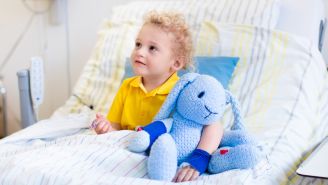Physical punishment—punishment that involves spanking, slapping, hitting or pulling, also known as corporal punishment—is one way parents discipline their kids. But spanking and other physical forms of discipline may have lasting consequences for children’s health and wellbeing.
A 2018 study published in the Journal of Pediatrics found that kids who were spanked, slapped or struck with an object as a form of punishment were more likely to have recently committed dating violence. The study’s authors surveyed 758 young people between the ages of 19 and 20-years old to draw that conclusion.
Other studies suggest that physical punishment is not even effective, and could take a toll on children’s development. Physical discipline may also be associated with certain mood and anxiety disorders, substance abuse and personality disorders, according to the American Academy of Pediatrics. A 2019 study, published in JAMA Network Open, supports this view. For the study, researchers analyzed data on 36,309 adults from the National Survey on Alcohol and Related Conditions. They found those who were subjected to child maltreatment, such as physical, emotional and sexual abuse or neglect, were more likely to exhibit antisocial behavior later in life. The same was true however, for those who weren’t abused or neglected as kids but experienced harsh physical punishment, such as pushing, grabbing, shoving, slapping or hitting. The study’s authors speculate that child abuse, physical punishment or both could account for nearly half of all antisocial behaviors among men and women in the United States.
So why are some parents still using this form of punishment and how bad is it really?
We talked to Felicia Nevarez, LCSW, a social worker at Medical City Green Oaks Hospital in Irving, Texas, to understand more about how physical punishment impacts a child, and the ways she recommends parents approach discipline instead.
Physical punishment: What is it exactly, and why exactly do parents use it?
Physical punishment can be described as a type of punishment used to correct a child’s behavior by way of physical force meant to cause pain or discomfort, says Nevarez. Spanking is one of the most common forms of physical punishment, but here are some of the others:
- Slapping, pinching or pulling
- Striking with an object like a paddle, belt, hairbrush, whip or stick
- Forcing a child to eat soap, hot sauce or any other unpleasant ingredients
Why do some parents choose to discipline their children this way? The answer to this question isn’t a simple one. According to the 2015 Parenting in America report from the Pew Research Center, one out of six parents admit to using spanking as a form of discipline some of the time.
There are many factors at play when we talk about just how many parents are still using physical punishment—race, geographical location, college education and a history of physical punishment are all factors. According to the report, African American parents are more likely to spank than white, Asian Americans or Latino parents and those without a college education are more like than those with a bachelor’s degree or graduate degree.
Choosing to physically punish your child may seem like the only option, especially if that’s how you were punished as a child.
Nevarez hears comments like, “I was spanked and I turned out fine” all the time—but the fact of the matter is, it can have long-lasting effects. And, even parents who have tried to steer away from physically punishing their children may revert back to spanking or slapping when they get angry.
Negative impacts of physical punishment
Over the years, there have been many studies intending to prove physical punishment can have short and long-term health effects on children. And it was in the 1990s when the connection between physical punishment and developmental problems first began.
In 2012, the Canadian Medical Association Journal published the report, Physical Punishment of Children: Lessons from 20 Years of Research, and the general consensus was that physical punishment:
- May increase the risk of developmental issues
- Cause aggression, especially towards parents, siblings or other children
- May prevent them from learning how to deal with anger or discomfort, so they revert to physical aggression in stressful situations
- Can confuse them—they may have trouble understanding why their caretaker is hurting them
- May lead to spousal violence and aggression later in life
And the 2019 study suggests that physical punishment and child maltreatment, occurring either separately or in conjunction with one another as a child, are associated with symptoms of antisocial personality disorder such as:
- Failure to conform to social norms; repeated commitment of unlawful behaviors resulting in arrests
- Deceitfulness, including repetitive lying, use of aliases or conning others for personal profit or pleasure
- Impulsivity or failure to plan ahead
- Irritability and aggressiveness, as indicated in repeated physical fights and assaults
- Reckless disregard for safety of self or others
- Consistent irresponsibility when it comes to work and financial obligations
The bottom line? Research shows that physical punishment does not provide positive benefits related to development or upbringing. In fact, it may even have negative effects during childhood, as well as adulthood.
You have to find the parenting style that’s right for you
Every parent has a different parenting style—and every child is completely different (different ages, different personalities and different stages of life) so a parenting style that works for your family, may not work with your neighbor’s.
Here are some of the ways Nevarez recommends you approach discipline with your child:
Communicate about rules and expectations: Communicating effectively about what you want your child to do (or not do) is key. Talking through family rules (with a positive tone of voice) and why you’ve established these rules will help them understand the correct behavior and the reasons you expect it.
Use positive reinforcement: In almost every parenting book, online resource or study, you’ll read about the effects of positive reinforcement—that is, giving your child verbal praise for good behavior.
We all like positive reinforcement. Knowing that our loved ones—the ones that are caring for us—are pleased with our actions, makes us feel good, even as adults, says Nevarez. And the same holds true for your career—it’s very likely you respond well to praise, and are motivated to keep up the good work. Kids react in the same way—if they receive praise for their behavior, that helps them behave appropriately, because they want to please the care taker, she adds.
When they do a good job with something, let them know and let them know why you’re proud of them, too. Say things like, “I think it’s wonderful you’re helping your little brother learn to ride a bike.” In turn, they’ll start to become more aware of what constitutes good behavior.
Give choices and consequences: It can also be helpful to give them choices, explain the consequences for those choices and follow through with those consequences, says Nevarez.
For example, you can say, “You can choose to pick up your toys and then we can go outside. Or, you can choose to leave your toys out and later on, you’ll have to take time to put things away, which won’t leave much time to go outside.” This can help the child understand that the consequence occurred because of the choice they made, rather than just because you’re giving the consequence.
Stay calm: Whether you’re setting rules, talking through consequences or giving praise, you always want to remain calm when talking with your child.
“A child can hear anger and frustration in your voice, so if you’re calm, they’re going to better understand what you’re discussing, which will encourage them to make better decisions,” says Nevarez.
Parenting is hard work, but you don’t have to go at it alone. HealthyChildren.org, KidsHealth.com and BoysTown.org are all great places to connect with other parents and get discipline tips from professionals.






